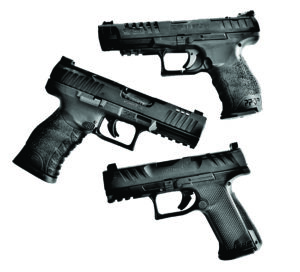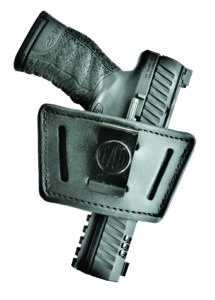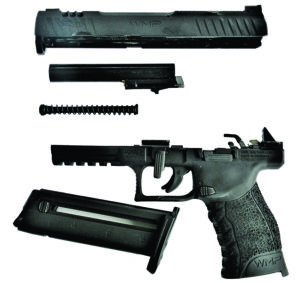he 22 Winchester Magnum Rimfire has enjoyed steady popularity since its introduction 65 years ago. The 22 WMR, or 22 Magnum, is a crackerjack cartridge that increases the range and killing power of a rimfire firearm. The cartridge differs considerably from the 22 Long Rifle. The hoary old 22 LR features a lead heel-based bullet pressed into the case. The 22 Magnum features a jacketed bullet crimped into the cartridge case. This makes the Magnum much more feed reliable. The 22 Magnum has been adapted to revolvers easily, but the cartridge has not been chambered in self-loading pistols as seamlessly. A rimmed cartridge case presents a design hurdle. Most 22 Magnum loads are designed for rifles and use slower-burning powder, with the Hornady Critical Defense round used in this test being an exception. As a result, the cartridges often leave considerable powder residue.
Three modern handguns we tested in this chambering recently were the KelTec PMR-30 PMR30TACGY in Tactical Grey coloring, $490; the Rock Island Armory XT 22 51996, $503; and the Walther WMP (Walther Magnum Pistol) 5220300, $549. All make claim to perfect reliability and good accuracy. They actually came very close, but only one exhibited perfect reliability.
How We Tested
We expanded the test program over our usual two to four loads. We usually use some type of FMJ loading for practice and a hollow point to confirm feed reliability, then proceed to a mix of three loads for accuracy testing from a benchrest. We used a total of 10 loads during this test. The loads used are listed in the Velocity Table as a point of interest, as well as the usual Range Data.
We wanted to test reliability with inexpensive FMJ loads, which are usually more lightly loaded, to the most potent loads and high-velocity offerings with 30-grain bullets as well as heavier 45-grain class loads. We used six CCI, one Winchester, one Armscor, and two Hornady loads. We also included some results from a 6½-inch-barrel revolver we recently tested for comparison, and, finally, we chronographed a rifle using 22 Magnum loads. The self-loading handguns generate significantly greater velocity than revolvers, we found. Handguns and velocity with high-intensity loads are unpredictable, and while similar handguns may post similar velocities, it isn’t always a given. The Walther seemed to generate the highest velocity with most loads, but then the Rock gave a 92-fps boost over the Walther with one load — from the same box of ammunition used to test the Walther. The Walther definitely generates more velocity than most revolvers. The revolvers tested with 22 Magnum loads were 6½-inch barrel handguns, the longest practical field length. As one rater noted, he will retire his Ruger Single Six from small-game hunting in favor of the Walther. The Walther, he feels, is like a rifle on the hip. All agree that in a pinch the 22 Magnum could be a life saver if you can shoot well, much more so than a revolver with only six rounds on tap.

All three makers stress properly loading the magazines is important for 22 Magnum feed reliability. We used the same drill when loading all three pistols. We slipped the long cartridges under the feed lips, and after loading three rounds, we tapped the back of the magazine to seat the cartridges fully to the rear. We also did not lower the follower to its lowest point and drop cartridges in. We pressed them in one at a time. The Walther WMP’s polymer magazine is easily loaded to full capacity, the best of the test in that regard, despite its lower round count.
The power of the cartridge, while respectable, isn’t something we recommend for personal defense, but we recognize many shooters will consider these guns for self defense regardless. Their better use, in our view, is as a field gun for small game and protection against feral dogs and bobcat-size pests. It compares well against the 32 H&R Magnum or 380 ACP for the recoil shy. The bottom line must be reliability, and the design of the cartridge itself is a problem. Rimfire cartridges are notorious for the occasional failure to ignite the priming compound. We ran a thorough test of the three guns with nine types of 22 Magnum ammunition for a total of 800 cartridges, spread out as evenly as possible among the three handguns. We liked all of the guns, but one had troubling function problems. Another was a bit large for most hand sizes. But one of this trio we recommend wholeheartedly, for the reasons we list below.
Gun Tests Grade: B
$549
The Walther WMP has received a lot of attention. Walther’s ad campaign stresses a duty to be ready. We certainly agree, although this may not be the right tool for some of us. Just the same, the popularity of the 22 Magnum cannot be overrated. Many who hike and camp deploy the 22 Magnum and don’t own another handgun. While we feel the cartridge is best reserved for game of 35 pounds or coyote in a pinch, a 22 Magnum on the hip makes folks feel better. If the pistol has a generous magazine capacity and is quite accurate, they have a firearm they may have confidence in. The Walther certainly gives you confidence, something not true of many other 22 Magnum self-loading pistols. The Walther also has a certain Walther flair and appearance. This will make it attractive to Walther fans. Just the same, no matter what type of defensive handgun you prefer, the Walther is a nice-shooting pistol and one of the fun guns of the past few years.
| Action Type | Double action |
| Overall Length | 8.2 in. |
| Overall Height | 5.64 in. |
| Maximum Width | 1.48 in. |
| Weight Unloaded | 27.8 oz. |
| Weight Loaded | 29.9 oz. |
| Slide | Black-phosphate aluminum alloy |
| Slide Retraction Effort | 12.0 lbs. |
| Receiver Material | Black polymer |
| Front Strap Height | 2.8 in. |
| Rear Strap Height | 3.75 in. |
| Barrel Length | 4.5 in. |
| Grip Panels | None |
| Grip Thickness | 1.25 in. |
| Grip Circumference | 5.75 in. |
| Magazines | (2) 15 round |
| Rear Sight | Serrated rear face, drift adjustable |
| Front Sight | Fiber-optic, fixed |
| Trigger Pull Weight | 4.5 lbs. |
| Trigger Span | 2.75 in. |
| Sight Radius | 6.4 in. |
| Safety | Trigger lever |
| Warranty | Lifetime |
| Telephone | (479) 242-8500 |
| Website | WaltherArms.com |
| Made In | Germany |

Your first impression of the WMP is that this is a big pistol. After handling it, you will realize you are correct in this assessment of its size. The slide is aluminum and the frame is polymer, making its weight manageable. The pistol’s slide is well finished with both rear and forward cocking serrations. The ejection port is generous. The front sight is a red fiber optic. The rear sight is a wedge-type design that may be moved with a brass punch and adjusted for windage. As delivered, the sights were properly regulated for 40-grain loads at 15 yards. The slide is optics ready, a big selling point in today’s red-dot-hungry world. Two optic plates and an additional rear sight are included in the package.
The rear of the slide reveals a hammer. The pistol resembles striker-fired Walther handguns, but this is actually a hammer-fired pistol. By racking the slide, the hammer is partially cocked. Pressing the trigger finishes cocking and dropping the hammer. This makes the pistol a true double-action-only model. The trigger press is smooth and relatively short. Trigger compression is a smooth 4.5 pounds, exactly as Walther specified. The pull weight was consistent, while the action felt smoother by the end of the test. The pistol doesn’t have a manual safety on the frame, but it does have a blade-type safety in the trigger face. The frame features a rail to accept a combat light, just the thing to spot a treed raccoon, one rater noted.

The WMP features a simple disassembly. Be certain the pistol is unloaded, lock the slide to the rear with the magazine removed, and rotate the takedown lever. The slide lock is released, and the slide runs forward. The recoil spring is a one-piece assembly. Remove the recoil-spring assembly, and next the barrel is easily removed. The barrel runs in a trunnion in the frame. The action is a simple blowback type.
We like the grip texture and slight finger grooves. The grip is the largest of the test, however. The finger and hand stretch would be more troubling in a harder kicking 9mm and is easily tolerated in this rimfire handgun. The slide lock is ambidextrous. The magazine release is unusual. Walther uses a Browning-type pushbutton magazine catch in some pistols and a paddle type in others. The WMP has both types. The WMP’s paddle release is individually articulated, so Walther may rightly the claim the magazine release has four points of operation. Walther 9mm pistols with paddle releases use a one-piece paddle, which is also ambidextrous. Our Walther fan among the raters remarked that whether you own either type of 9mm Walther with either magazine release, the WMP will accommodate your muscle memory. The trigger guard is squared and serrated on the front.

Slide racking is easy enough. The pistol comes on target easily and is simple to handle. Aim and press the trigger. The hammer rocks back easily and the trigger breaks cleanly. Offhand accuracy was easy. The pistol fired good combat groups. The only difficulty was trigger reach. Several times during the test, the raters missed pressing the trigger. The shooter would quickly place the finger tip on the trigger face, but fail to completely press the safety lever flush with the trigger. Even those raters who own and shoot Walther handguns on a regular basis had difficulty reaching the trigger sometimes. Eventually, all raters learned the drill and managed the trigger well. While it is possible to acclimate to the trigger, this isn’t something we would accept on a pistol intended for personal defense. The WMP is a recreational firearm, in our view. Those with long fingers, including a female rater with small hands but long, slender fingers, did not experience a problem with trigger reach.
After a positive experience with offhand combat fire, we settled down to accuracy testing from a solid benchrest, using three loads. We used the Winchester 40-grain FMJ, CCI’s 40-grain Maxi Mag, and Hornady 45-grain Critical Defense. The Walther proved to be the most accurate handgun tested. Several five-shot groups fell into less than 2 inches. The Walther suffered a single failure to fire. The cartridge appeared to have taken a good whack on the case rim, and it ignited on the second try. This was the only dent in the Walther’s reliability, and we have to blame the ammo.
Our Team Said: The Walther WMP is an accurate handgun. The question of handfit is a nagging problem, however. We feel that Walther missed a chance to offer a more tractable and compact pistol. After all, the recently introduced PDP F-Series pistol features a grip designed for female hand structure. We rated the WMP down a full grade based on the large grip and long trigger reach. As one of the raters noted, if you are a fan of the Glock 20 or Glock 21 and enjoy firing those handguns and use them well, the WMP will be a good fit for you.
22 WMR (22 Magnum) Range Data
We fired groups at 25 yards from a solid benchrest position using an MTM CaseGard K-Zone Shooting Rest. We used a Competition Electronics Pro Chrony to measure velocity. We placed the front screen of the chronograph 10 feet from the muzzles of the firearms.| Winchester Super-X 40-grain FMJ | Walther WMP | Rock Island Armory XT22 | KelTec PMr-30 |
| Average Velocity | 1260 fps | 1282 fps | 1249 fps |
| Muzzle Energy | 141 ft.-lbs. | 146 ft.-lbs. | 139 ft.-lbs. |
| Small Group | 1.1 in. | 2.0 in. | 1.6 in. |
| Average Group | 1.8 in. | 2.4 in. | 2.3 in. |
| CCI Maxi-Mag 40-grain JHP | Walther WMP | Rock Island Armory XT22 | KelTec PMr-30 |
| Average Velocity | 1421 fps | 1382 fps | 1330 fps |
| Muzzle Energy | 179 ft.-lbs. | 170 ft.-lbs. | 157 ft.-lbs. |
| Small Group | 1.5 in. | 1.8 in. | 1.6 in. |
| Average Group | 2.0 in. | 2.5 in. | 2.0 in. |
| Hornady Critical Defense 45-grain FTX | Walther WMP | Rock Island Armory XT22 | KelTec PMr-30 |
| Average Velocity | 1254 fps | 1293 fps | 1235 fps |
| Muzzle Energy | 157 ft.-lbs. | 167 ft.-lbs. | 152 ft.-lbs. |
| Small Group | 1.7 in. | 2.1 in. | 1.8 in. |
| Average Group | 2.1 in. | 2.6 in. | 2.2 in. |
Additional 22 WMR (22 Magnum) Velocity Data
| Load | Walther WMP | Rock Island Armory XT22 | KelTec PMR-30 |
|---|---|---|---|
| CCI VNT 30 grain | 1490 fps | 1433 fps | 1409 fps |
| CCI V-Max 30 grain | 1516 fps | 1550 fps | 1477 fps |
| CCI TNT 30 grain | 1568 fps | 1660 fps | 1498 fps |
| CCI Game Point 40 grain | 1401 fps | 1366 fps | 1345 fps |
| Armscor JHP 40 grain | 1310 fps | 1274 fps | 1299 fps |
Comparative 22 WMR (22 Magnum) Velocity
We used a Competition Electronics Pro Chrony to measure velocity. We placed the front screen of the chronograph 10 feet from the muzzles of the firearms.| Hornady V-Max | CZ 512 Rifle | Walther | Rock Island Armory | KelTec |
| 30-grain 83202 | 20.5-inch Barrel | WMP | XT 22 | PMR-30 |
| Average Velocity | 2371 fps | 1522 fps | 1539 fps | 1498 fps |
| CCI Maxi-Mag | CZ 512 Rifle | Walther | Rock Island Armory | KelTec |
| 40-grain JHP | 20.5-inch Barrel | WMP | XT 22 | PMR-30 |
| Average Velocity | 2260 fps | 1421 fps | 1382 fps | 1330 fps |
| Hornady Critical Defense | Heritage Revolver | Walther | Rock Island Armory | KelTec |
| 45-grain FTX | 6.5-inch Barrel | WMP | XT 22 | PMR-30 |
| Average Velocity | 1160 fps | 1254 fps | 1293 fps | 1235 fps |
| CCI Maxi-Mag | Heritage Revolver | Walther | Rock Island Armory | KelTec |
| 46-grain Segmented HP | 6.5-inch Barrel | WMP | XT 22 | PMR-30 |
| Average Velocity | 1201 fps | 1299 fps | 1257 fps | 1242 fps |



























